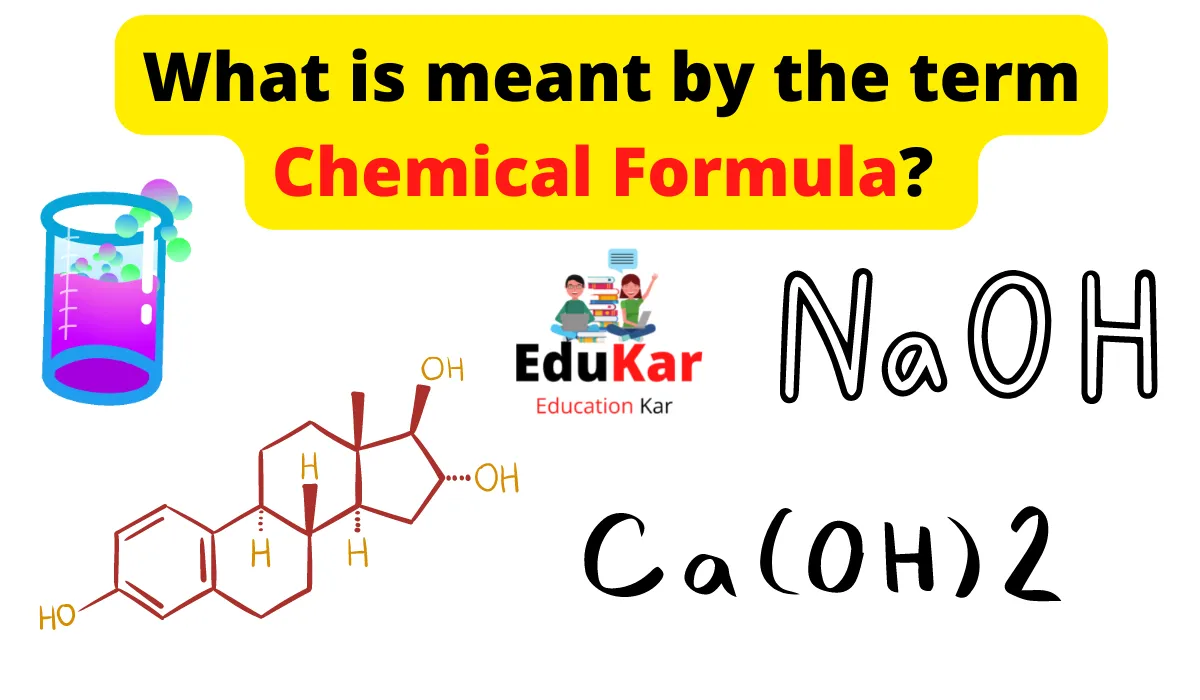There are many terms and phrases that are used in chemistry, most of which you might not be familiar with. But the term Chemical Formula is one that you might have heard before. It is a combination of the atomic symbol of the element and the number of atoms in its molecular structure. This blog will break down the term its definition and how it is used in chemistry.

What is Chemical Formula?
A chemical formula is a mathematical representation of a chemical compound. In chemistry, the composition of a chemical substance is often represented by its chemical formula. Most often, a chemical formula displays the chemical’s structure, including the number and type of atoms as well as their arrangement in molecules.
The numerical value of the chemical formula is computed with respect to an atom’s atomic mass unit. The number of valence electrons is represented by the term oxidation number. A chemical formula is typically represented in a type of chemical shorthand.
Chemical Formula Examples:
The chemical formula for calcium carbonate is CaCO3
The chemical formula for hydrochloric acid is HCl
The chemical formula for sodium chloride(Salt) is NaCl
The chemical formula for carbon dioxide is CO2
The chemical formula for sulfuric acid is H2SO4
What are types of chemical formula?
here are three types of chemical formula that are commonly used. The three types of chemical formula are empirical formula, molecular formula, and structural formula.
Empirical formula is the simplest type of formula and can only provide the ratio of atoms.
Molecular formula is a formula that provides the ratio of atoms and molecules, but it cannot provide the ratio of ions.
Structural formula is a formula that provides the ratio of atoms and molecules, ions, and the arrangement of molecules.
How are chemical formulas formed?
Chemical formulas are formed by combining atoms, ions, and molecules by means of chemical reactions.
In order to understand how chemical formulas are formed, you need to understand what atoms, molecules, and ions are.
Atoms are the smallest units in the periodic table. They are made up of a nucleus and electrons. Electrons are negatively charged, and they are whirling around the nucleus. The nucleus is made up of protons and neutrons. Protons have positive charge, and neutrons have no charge. Neutrons are the heaviest particles in the nucleus.
Molecules are made up of atoms. There are two types of molecules. One type is called a homogenous molecule, where the atoms are arranged in a repeating pattern. The other type is called a heterogeneous molecule, where the atoms are not arranged in a repeating pattern. Ions are positively charged particles. They are made up of one or more atoms. The number of electrons that a molecule has determines its chemical formula.
How are chemical formulas used?
Chemical formulas are used to determine the composition of a substance and its reactivity, as well as to predict the chemical behaviour of a substance. Chemical formulas are used in the following ways:
- to identify substances,
- to predict their properties,
- to determine whether a substance is hazardous,
- to analyze a substance,
- to create a manufacturing process,
- to create a synthesis,
- to create a synthesis with an unknown reactivity,
- to synthesize a substance with an unknown reactivity,
- to find pathways to synthesize a compound,
- to correlate with other chemical formulas, and t
- o find a substance with a certain formula in the environment.
Why are chemical formulas important?
The chemical formulas you learn in school are important for the understanding of concepts in chemistry. One way that formulas are important is due to their utility. Using formulas gives students the ability to calculate values for quantities.

If students are given a formula, they can easily calculate the specific amount that will be involved in a particular reaction. In addition to their usefulness in calculations, formulas also provide students with a clear understanding of the scientific principles involved in chemical reactions. However, not all chemical formulas are drawn in the same way.
Chemical formulas often have a specific structure that helps students to quickly interpret a particular formula. It is these formulas that are used in the sciences and in many other fields of study.
FAQs related to Chemical Formula:
How do you remember chemical formulas?
When you are given a chemical formula, it can be challenging to remember. One way to remember it is to just write it down. However, this could be too time-consuming. You can use a mnemonic device to remember the formula. For example, if you were given the formula for water, you could picture a little boy holding a water jug. This would help you remember the formula.
What are the most important chemical formulas?
Vitally important chemical formulas that are necessary for human life include oxygen (O2), carbon dioxide (CO2), nitrogen (N2), and hydrogen (H2).
Conclusion
A chemical formula is a set of symbols used to represent the elements of a compound. The chemical formula is the chemical structure of a compound. The formula is written in the form of a chemical equation.
We hope you enjoyed our informative blog post. We discussed what the term ‘chemical formula’ means and what forms it can take. It’s a must-know for any chemistry enthusiast, but even for those who don’t have a background in chemistry, we hope it was a little bit informative and helpful! If you have any questions, please don’t hesitate to reach out to us at www.edukar.in. Thank you for reading, we would love to hear from you!





